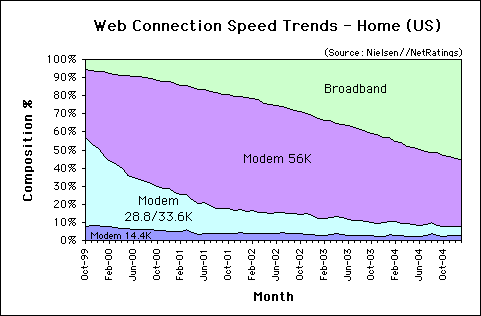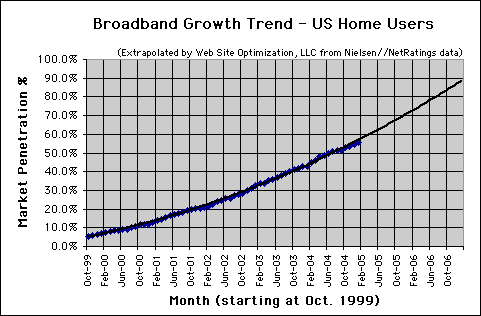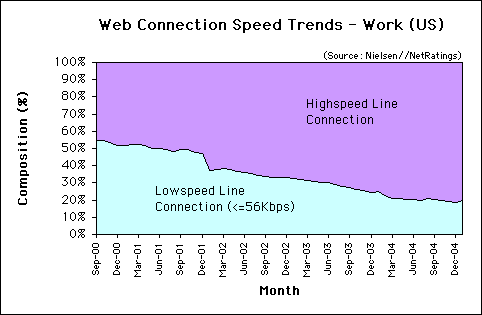Broadband users outpurchased narrowband users by over 2 to 1 over the holidays, according to a recent survey by Nielsen/NetRatings. While women now outpace men in European Internet uptake, the digital divide remains for age, education, and income, according to a new survey by the European Commission. In January, broadband penetration among active Internet users in the U.S. grew by 0.78 percentage points to 55.47%. 44.53% of US home users dial into the Internet with “narrowband” connections of 56Kbps or less.
The charts below, derived from Nielsen//NetRatings data, show trends in connection speeds to the Internet for United States users.*
Home Connectivity in the US
In January 2005, most active Internet users connect from home with broadband connections. Among narrowband users, 36.91% use 56Kbps modems, 5.12% use 28/33.3Kbps, and 2.5% use 14.4Kbps modems. In total, 44.53% of home users in the US connect to the Internet at 56Kbps or less (see Figure 1).
Web Connection Speed Trends – Home Users (US)
Figure 1: Web Connection Speed Trends – Home Users (US)
Source: Nielsen//NetRatings
Broadband Growth in the US
Broadband penetration in the US grew by 0.78 points to 55.47% in January, up from 54.69% in December. This increase is below the average increase in broadband of 1 point per month over the previous twelve months. Broadband share in the US should exceed 70% by December of 2005 (see Figure 2).
Broadband Connection Speed Trend – Home Users (US)
Figure 2: Broadband Connection Speed Trend – Home Users (US)
Extrapolated from Nielsen//NetRatings data
Work Connectivity
Most workers in the US enjoy high-speed connections to the Internet. Most use a high-speed line such as a T1 connection, and share bandwidth between computers connected to an Ethernet network. The speed of each connection decreases as more employees hook up to the LAN. As of January of 2005, of those connected to the Internet, 80.19% of US users at work enjoy a high-speed connection, down 1.2 percentage points from 81.39% in December. At work, 19.81% connect at 56Kbps or less (see Figure 3).
Web Connection Speed Trends – Work Users (US)
Figure 3: Web Connection Speed Trends – Work Users (US)
Source: Nielsen//NetRatings
Broadband Users Buy 69% of Online Purchases
More than two-thirds of all online purchases are made by broadband users, according to Nielsen//NetRatings. 69 percent of retail purchases online were conducted on broadband connections, versus 31 percent of purchases transacted by narrowband connections. Broadband users also spent 34 percent more per purchase ($158.21 versus $117.89) than narrowband users, with a higher conversion rate (26% versus 21%).
Further Reading
- eInclusion revisited: The Local Dimension of the Information Society (see the PDFs)
- “Women and the elderly are crossing the digital divide, but the poor still lag behind.” The Digital Divide is still present in Europe, says a new report by the European Commission. Higher access to the Internet and computer skills can help people escape poverty. Broadband has been adopted in the major cities, but has been slow to flow out to rural areas, “aggravating the division between urban and rural areas.” Internet penetration has grown from 34.3% in 2001 to 43.5% in June of 2003 for the EU 15. Some other technology penetration rates in the EU 15 are: television is nearly ubiquitous at 90% penetration, mobile phone usage is 70%, and computer usage is at 52% of the population. Europa.eu.int, Feb. 14, 2005
- More Than Two Thirds of Online Retail Purchases are Transacted Via Broadband (PDF)
- Broadband users dominate online purchasing, making over two-thirds of online purchases during November 2004. Based on Nielsen//NetRatings’ MegaView Online Retail survey, Jan. 19, 2005.
- Nielsen//NetRatings
- Provides the US broadband data (percentage of active Internet users) for the Bandwidth Report.
- Online Banking 2005: A Pew Internet Project Data Memo
- “Internet users with high-speed connections, those with six or more years of experience, and those between 28-39 years old are the most likely to bank online.” Pew Internet, Feb. 9, 2005
*Note that Nielsen//NetRatings reports the percentage of active Internet users that use broadband from home, not broadband households. NetRatings uses a panel of 40,000 to 50,000 people with software meters installed on their computers. These meters detect connection speeds. Each month they do an enumeration study to call a number of people to calibrate the panel by adjusting weightings to match the population at large.
The Bandwidth Report is featured monthly on URLwire – news of useful and unique web content since 1994.



